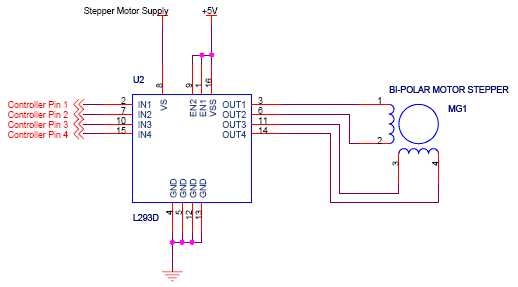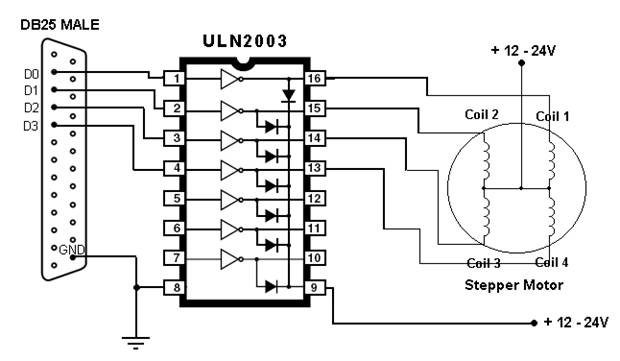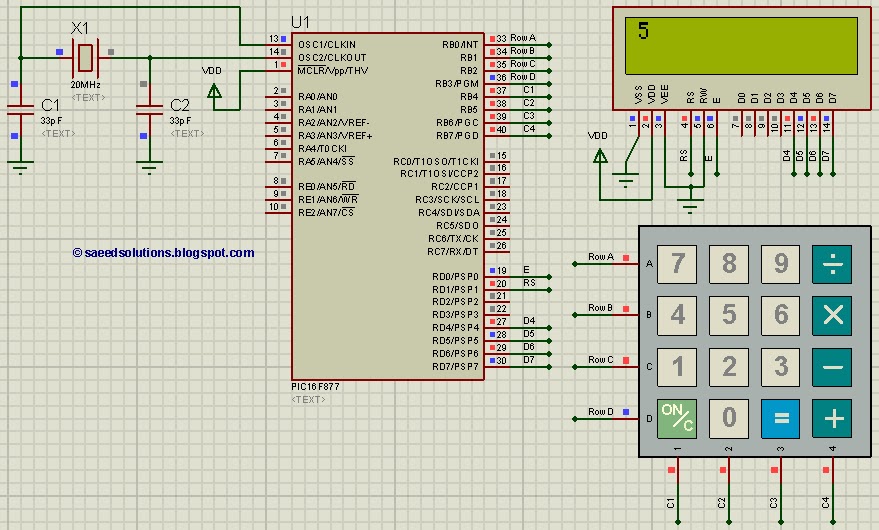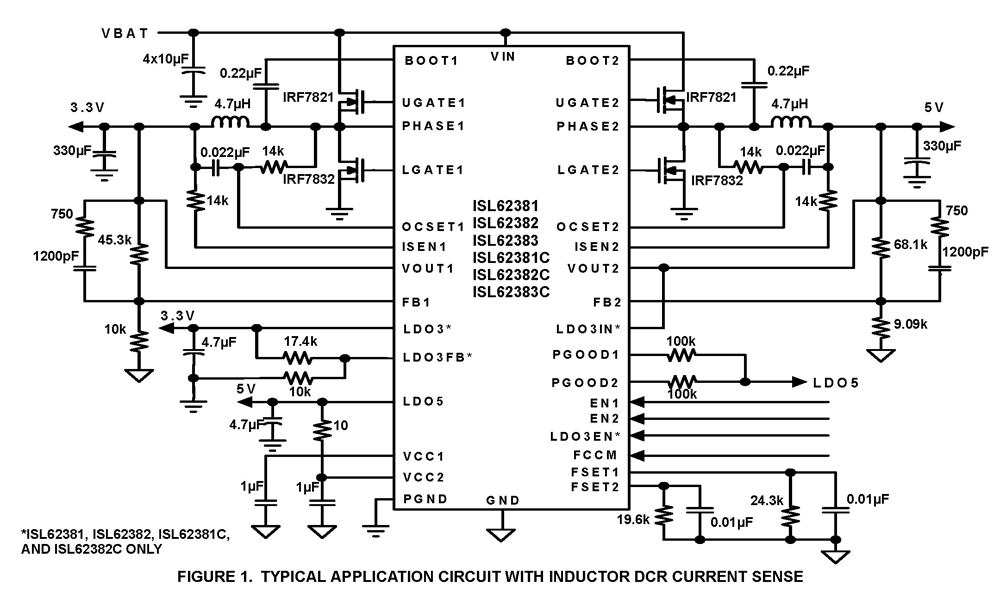
R5000 Computer Interface
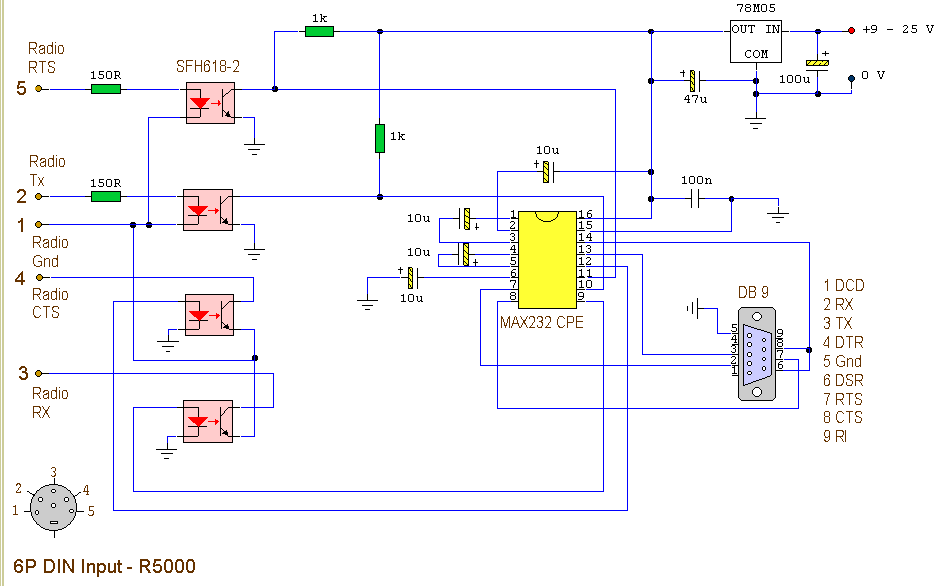
This circuit is a modified version of an original interface on QSL Net. It is a fully isolated interface allowing computer control of the Trio/Kenwood R5000 receiver. Separate software is needed to control the receiver. The R5000 receiver is an all-mode full-featured receiver covering 30-30MHz. This receiver is now discontinued but there are still plenty to be found on the second-hand market. It has an analog field strength meter, two built-in noise reducers, and a 6 Pin DIN output on the back panel. It is this DIN connector that interfaces to a PC, allowing software control over the receiver. The R5000 receiver outputs are TTL level compatible, but to interface with the PC serial port, RS232 standards are required. All the work is done here by the MAX232 IC. Working from a single 5V regulated supply, this IC will buffer and shift the TTL levels of the receiver to the standard required by the RS232 serial port. The output signals are shown correctly wired for a 9 Pin D type connector; most PCs have at least two of these connectors on the rear. The signals from the R5000 receiver are physically isolated by four opto-isolators, SFH618. The receiver's transmit and Ready to Send (RTS) outputs have series 150-ohm resistors before the isolators. The receive and Clear to Send (CTS) inputs are fed directly to the opto-isolator inputs. All the opto-isolator does is relay on/off conditions between input and output, but as there is no direct connection between input and output, physical and spatial separation is achieved. Sadly, the R5000 is discontinued, but there are still plenty available on the second-hand market. As for control software, a search on Google should prove useful.
The described circuit serves as an interface between a computer and the Trio/Kenwood R5000 receiver, facilitating remote control through software. The design incorporates a fully isolated architecture, which is crucial for preventing electrical noise and ensuring the integrity of signals exchanged between the computer and the receiver. The isolation is primarily achieved through the use of four opto-isolators (SFH618), which provide a barrier that protects both devices from potential damage caused by voltage spikes or ground loops.
The MAX232 integrated circuit is central to this interface, converting TTL-level signals from the R5000 into RS232-compatible signals suitable for communication with the PC. This conversion is essential because the R5000 outputs signals at TTL levels (typically 0-5V), while RS232 standards require different voltage levels (typically ±12V). The MAX232 operates from a regulated 5V power supply, ensuring stable performance.
The connection to the PC is made through a 9 Pin D type connector, which is standard on many computers. The circuit includes series 150-ohm resistors on the RTS and transmit lines to protect the opto-isolators from excessive current. The receive and CTS lines are connected directly to the opto-isolators, allowing for efficient signal transmission without additional components that could introduce delay or distortion.
Overall, this circuit provides a robust solution for integrating the R5000 receiver with a PC, enabling users to control the receiver remotely with appropriate software. Despite the discontinuation of the R5000, its availability in the second-hand market allows enthusiasts to utilize this sophisticated receiver with modern computing technology. For software options, users are encouraged to search online for compatible applications that can take advantage of this interface.This circuit is a modified version of an original interface on QSL Net. It is a fully isolated interface allowing computer control of the Trio/Kenwood R5000 receiver. Separate software is needed to control the receiver. The R5000 receiver is an all-mode full featured receiver covering 30-30MHz. This receiver is now discontinued but there are still plenty to be found on the second hand market. It has an analogue field strength meter, two built-in noise reducers and a 6 Pin DIN output on the back panel. It is this DIN connector that interfaces to your humble PC allowing software control over the receiver.
The R5000 receiver outputs are TTL level compatible, but to interface to the PC serial port, RS232 standards are required. All the work is done here by the MAX232 IC working from a single %V regulated supply this IC will buffer and shift the TTL levels of the receiver to the standard required by the RS232 serial port.
The output signals are shown correctly wired for a 9 Pin D type connector, most PC have at least two of these connectors on the rear. The signals from the R5000 receiver are physically isolated by 4 opto-isolators, SFH618. The receivers transmit and Ready to Send (RTS) outputs have series 150 ohm resistors before the isolators.
The receive and Clear to Send (CTS) inputs, are fed direct to the opto-isolator inputs. All the opto-isolator does is relay on/off conditions between input and output, but as there is no direct connection between input and output, physical and spacial separation is achieved. Sadly the R5000 is discontinued, but there are still plenty available on the second hand market. As for control software, a search on Google should prove useful. 🔗 External reference
The described circuit serves as an interface between a computer and the Trio/Kenwood R5000 receiver, facilitating remote control through software. The design incorporates a fully isolated architecture, which is crucial for preventing electrical noise and ensuring the integrity of signals exchanged between the computer and the receiver. The isolation is primarily achieved through the use of four opto-isolators (SFH618), which provide a barrier that protects both devices from potential damage caused by voltage spikes or ground loops.
The MAX232 integrated circuit is central to this interface, converting TTL-level signals from the R5000 into RS232-compatible signals suitable for communication with the PC. This conversion is essential because the R5000 outputs signals at TTL levels (typically 0-5V), while RS232 standards require different voltage levels (typically ±12V). The MAX232 operates from a regulated 5V power supply, ensuring stable performance.
The connection to the PC is made through a 9 Pin D type connector, which is standard on many computers. The circuit includes series 150-ohm resistors on the RTS and transmit lines to protect the opto-isolators from excessive current. The receive and CTS lines are connected directly to the opto-isolators, allowing for efficient signal transmission without additional components that could introduce delay or distortion.
Overall, this circuit provides a robust solution for integrating the R5000 receiver with a PC, enabling users to control the receiver remotely with appropriate software. Despite the discontinuation of the R5000, its availability in the second-hand market allows enthusiasts to utilize this sophisticated receiver with modern computing technology. For software options, users are encouraged to search online for compatible applications that can take advantage of this interface.This circuit is a modified version of an original interface on QSL Net. It is a fully isolated interface allowing computer control of the Trio/Kenwood R5000 receiver. Separate software is needed to control the receiver. The R5000 receiver is an all-mode full featured receiver covering 30-30MHz. This receiver is now discontinued but there are still plenty to be found on the second hand market. It has an analogue field strength meter, two built-in noise reducers and a 6 Pin DIN output on the back panel. It is this DIN connector that interfaces to your humble PC allowing software control over the receiver.
The R5000 receiver outputs are TTL level compatible, but to interface to the PC serial port, RS232 standards are required. All the work is done here by the MAX232 IC working from a single %V regulated supply this IC will buffer and shift the TTL levels of the receiver to the standard required by the RS232 serial port.
The output signals are shown correctly wired for a 9 Pin D type connector, most PC have at least two of these connectors on the rear. The signals from the R5000 receiver are physically isolated by 4 opto-isolators, SFH618. The receivers transmit and Ready to Send (RTS) outputs have series 150 ohm resistors before the isolators.
The receive and Clear to Send (CTS) inputs, are fed direct to the opto-isolator inputs. All the opto-isolator does is relay on/off conditions between input and output, but as there is no direct connection between input and output, physical and spacial separation is achieved. Sadly the R5000 is discontinued, but there are still plenty available on the second hand market. As for control software, a search on Google should prove useful. 🔗 External reference
